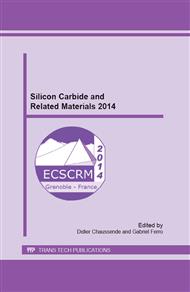p.403
p.407
p.411
p.416
p.420
p.424
p.428
p.432
p.436
Silicon Nitride Encapsulation to Preserve Ohmic Contacts Characteristics in High Temperature, Oxygen Rich Environments
Abstract:
Ohmic contacts with low contact resistance, smooth surface morphology, and a well-defined edge profile are essential to ensure optimal device performance. Ohmic contacts often require annealing under vacuum at over 1000 °C, whilst high-κ dielectrics are usually annealed in O2 rich ambient at temperatures of 800 °C or less, affecting the specific contact resistivity (ρC) and RMS surface roughness. Therefore, protection of the Ohmic contacts during the annealing of a high-κ dielectric layer is a key enabling step in the realisation of high performance MOSFET structures. In order to prevent damage during the high-κ formation, a passivation layer capable of protecting the contacts during annealing is required. In this work we have investigated the suitability of PECVD silicon nitride as a passivation layer to protect Ohmic contacts during high temperature, oxygen rich annealing.
Info:
Periodical:
Pages:
420-423
Citation:
Online since:
June 2015
Keywords:
Price:
Сopyright:
© 2015 Trans Tech Publications Ltd. All Rights Reserved
Share:
Citation:


